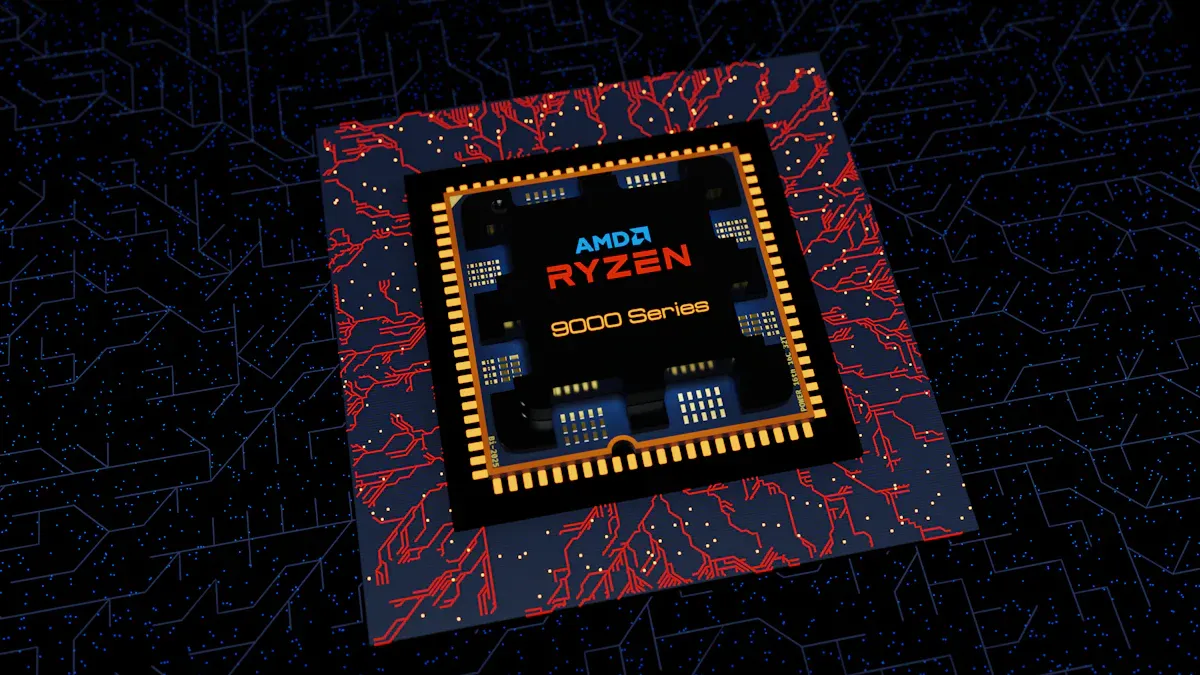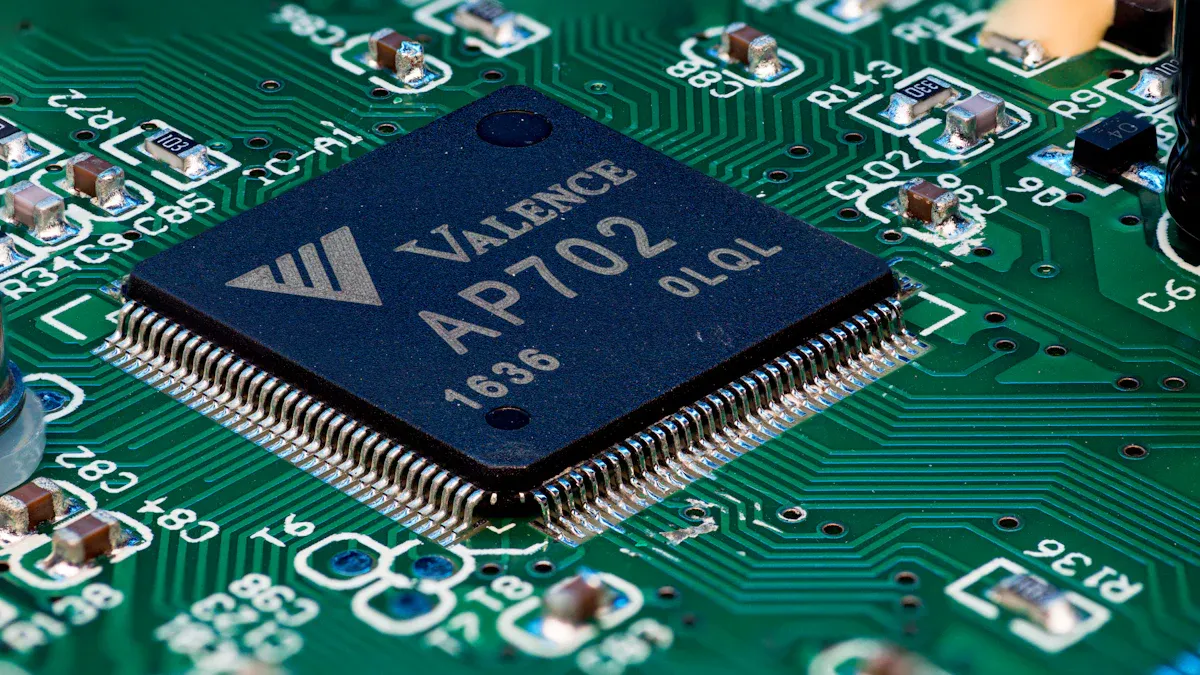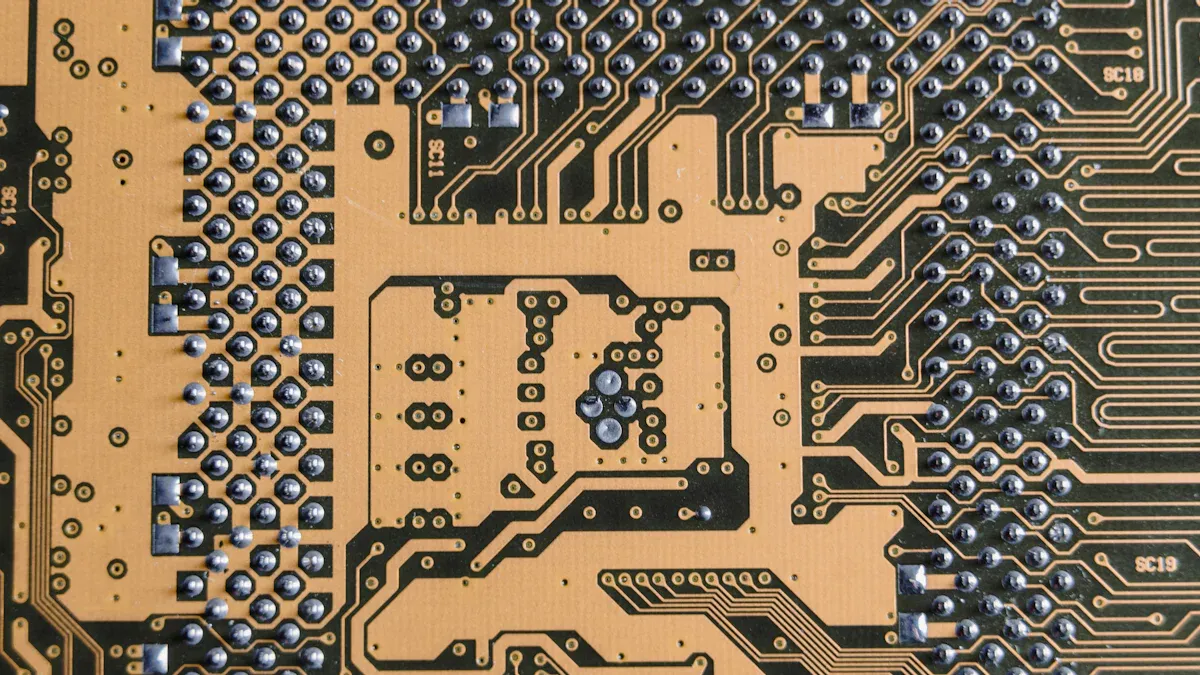EPF10K50RI240-4N: Unlocking Its Power and Specs

The EPF10K50RI240-4N represents a specific Altera FLEX 10K FPGA. These devices hold significant importance in reconfigurable logic applications. They offer crucial reconfigurability, enabling design adjustments and optimization without physical hardware redesign. This capability allows high integration, consolidating multiple functions into a unified, efficient system. This post explores its key specifications and capabilities. Readers will gain an understanding of its potential for diverse designs.
Key Takeaways
The EPF10K50RI240-4N is an Altera FLEX 10K FPGA. It is a special chip that can change how it works after it is made. This chip helps make electronic designs flexible.
This FPGA has 2,880 Logic Elements and 6 Embedded Array Blocks. These parts help it do many tasks at once. It also has 189 pins to connect to other devices.
The chip works well in tough places. It can handle temperatures from -40°C to +85°C. It also uses little power, especially when it is not actively working.
Engineers use this FPGA for many things. These include processing signals, making custom controls, and testing new designs. It can also help keep older electronic systems working.
The EPF10K50RI240-4N is still useful today. It helps with older systems and for learning. Its design and tools make it good for many projects.
Understanding the EPF10K50RI240-4N

Defining the EPF10K50RI240-4N
The EPF10K50RI240-4N is an Altera FLEX 10K FPGA. This device belongs to a family of embedded programmable logic devices. It offers mid-density logic capabilities. The EPF10K50RI240-4N provides flexible logic, built-in memory, and various input/output options. It uses SRAM technology, which allows for easy reprogramming. The device includes built-in JTAG support for testing and configuration. It features efficient routing with FastTrack® routing. It also incorporates carry chains for arithmetic logic and employs clock trees for predictable timing and efficient performance.
Family and Context
The Altera FLEX 10K family quickly succeeded the Flex 8000 FPGA series. This family was notable as the first FPGA series to incorporate embedded RAM blocks. Altera initially referred to the Flex 8000 and FLEX 10K devices as 'LUT based PLDs'. This was due to concerns about Xilinx's FPGA patents at the time. In 1996, Altera introduced the 10K100 chip. This chip featured 10 million transistors and was the industry's largest capacity chip. The FLEX 10K series marked a significant advancement in FPGA technology.
Core Purpose
Altera FLEX 10K FPGAs serve several important general use cases. They are designed for efficient memory and specialized logic functions. Their Embedded Array Blocks (EABs) enable high-performance applications. These FPGAs can handle data processing and storage simultaneously. They are adaptable to various digital ecosystems. The MultiVolt I/O interface supports different input/output voltage levels. This simplifies system design by ensuring compatibility with many peripheral devices. With low power consumption, often less than 0.5 mA in standby mode, these FPGAs are ideal for portable and battery-operated devices. Their wide operating temperature range and high reliability also make them suitable for automotive applications. They can perform tasks like sensor data processing and control units in vehicles.
Key Architectural Specifications

Understanding the core architectural specifications of the EPF10K50RI240-4N reveals its capabilities. These details define how the device processes logic and manages data.
Logic Elements (LEs)
Logic Elements (LEs) form the fundamental building blocks of Altera FPGAs. The EPF10K50RI240-4N features 2,880 LEs. Each LE typically contains a 4-input Look-Up Table (LUT), a flip-flop, carry logic, and a cascade chain. This structure allows stacking multiple LEs to form larger logic expressions. Engineers organize LEs into larger groups called Logic Array Blocks (LABs). These LEs contribute to the FPGA's core dynamic power consumption. This power charges and discharges internal node capacitance and flows through internal resistive elements.
Logic Array Blocks (LABs)
The EPF10K50RI240-4N contains 360 Logic Array Blocks (LABs). LABs are fundamental components within the Altera FLEX 10K architecture. They sit alongside Embedded Array Blocks (EABs). Each LAB consists of multiple Logic Elements (LEs) designed for general-purpose logic functions. A Local Interconnect connects these LEs within a LAB, which facilitates flexible logic implementation. Column and Row Interconnects manage communication between LABs, EABs, and I/O Elements (IOEs). These interconnects support complex routing paths and data flow across different logic sections. LABs are organized in rows and columns at the center of the logic arrays. Interconnecting lines enable flexible signal routing throughout the device.
Embedded Array Blocks (EABs)
The EPF10K50RI240-4N includes 6 Embedded Array Blocks (EABs). The FLEX 10KA family was among the first to integrate memory blocks within FPGA architecture, introducing EABs. These EABs significantly enhance logic design flexibility. EABs serve as built-in memory. They can handle functions like RAM, ROM, or complex logic requiring more storage. This increases the chip's flexibility by combining memory with logic. EABs are versatile memory and logic blocks. Designers can configure them as RAM, ROM, or custom logic to suit various digital designs. EABs connect to other FPGA components like LABs and IOEs via Local, Row, and Column Interconnects. This ensures efficient data flow. Internally, memory can be configured in various sizes, such as 256 × 8 or 512 × 4. They use D Flip-Flops for data stability. Write Enable (WE) lines control data writing, and Address lines manage data storage and retrieval. EABs support diverse data output sizes and utilize Multiplexers (MUXes) and Flip-Flops for data management and synchronization. They are crucial for implementing memory and logic functions within the FPGA. They contribute to high-performance applications by enabling simultaneous data processing and storage.
Total RAM Bits
The EPF10K50RI240-4N features a total on-chip RAM capacity of up to 40,960 bits. This memory is organized into embedded array blocks (EABs). Each EAB provides 2,048 bits. The device can utilize its full RAM capacity without reducing the available logic. This allows for efficient data handling and memory-intensive operations.
User I/O Pins
The device offers 189 user I/O pins. This count is crucial for connectivity. It determines how many external signals the FPGA can interact with. A higher I/O count allows for more complex interfaces with other components in a system.
Gate Count
The EPF10K50RI240-4N has a gate count of 116,000. The gate count of an FPGA indicates its capacity to implement intricate logic functions. It also shows its ability to accommodate extensive designs. This number quantifies the logic capacity by estimating the number of 2-input NAND gates needed to realize comparable logic. This allows for the comparison of different FPGA devices.
Package Type
Speed Grade
The speed grade for this device is -4. This number signifies the maximum operating frequency and performance characteristics of the FPGA. A lower (more negative) number generally indicates faster performance.
Manufacturing Technology
The EPF10K50RI240-4N utilizes 0.42um manufacturing technology. This technology is part of the FPGA FLEX 10K Family. It enables the device to feature 50K Gates and 2880 Cells. The device operates at 125MHz and uses a 5V power supply. It comes in a 240-Pin RQFP package.
Performance and Electrical Characteristics
Engineers must understand the performance and electrical characteristics of an FPGA. These details show how the device operates under different conditions. They also highlight its power needs and speed limits.
Operating Voltage
The EPF10K50RI240-4N operates within a specific voltage range. The operating supply voltage for the device is typically 5 V. However, the supply voltage range for the EPF10K50RI240-4N is 4.5V to 5.5V. This range ensures stable operation. The core supply voltage has a minimum of 4.75V and a maximum of 5.25V. The I/O supply voltage can go up to 5.5V. Some documentation also lists the operating voltage as 3.3V, indicating flexibility or different versions.
Voltage Type | Minimum (V) | Maximum (V) |
|---|---|---|
Core Supply Voltage | 4.75 | 5.25 |
I/O Supply Voltage | N/A | 5.5 |
Operating Supply Voltage | 4.5 | 5.5 |

Clock Frequencies
The clock frequency determines the speed at which the FPGA processes data. The EPF10K50RI240-4N offers robust clocking capabilities. It can achieve a maximum frequency of 125MHz. This speed allows the device to handle many digital signal processing tasks. It also supports various control applications. Designers must consider this maximum frequency when planning their system's timing.
Power Consumption
Power consumption is a critical factor for any electronic device. The FLEX 10K family, which includes this device, is known for its low power use. In standby mode, most devices in this family consume less than 0.5 mA. This makes them suitable for battery-powered applications. During active operation, the device typically draws 10 mA when the operating supply voltage is 5 V. Engineers must calculate total power needs based on the specific design and operating conditions.
Temperature Range
The operating temperature range defines the environmental conditions where the FPGA functions reliably. The EPF10K50RI240-4N has an industrial operating temperature range. It works from -40°C to +85°C. This wide range means the device can perform in harsh environments. It suits industrial controls, automotive systems, and outdoor equipment. The minimum operating temperature is -40°C. The maximum operating temperature is +85°C. This ensures consistent performance across various thermal conditions.
Design and Development
Designing with FPGAs requires specific tools and methods. Engineers follow clear steps to turn their ideas into working hardware.
Development Tools
Engineers use specialized software for Altera FLEX 10K devices. Altera development systems support Windows-based PCs, SunSPARCstation, and HP 9000 Series 700/800 workstations. These systems provide software design support and automatic place-and-route functions. Additional design entry and simulation support comes from EDIF 2 0 0 and 3 0 0 netlist files, Library of Parameterized Modules (LPM), and DesignWare components. Verilog HDL, VHDL, and other interfaces work with popular EDA tools. These tools come from manufacturers like Cadence, Exemplar Logic, Mentor Graphics, OrCAD, Synopsys, Synplicity, VeriBest, and Viewlogic. The FLEX-10K devices are compatible with a range of design software and hardware programming tools. This ensures smooth integration into existing technological setups with minimal compatibility issues.
Programming Methods
FPGAs need configuration to perform their intended functions. Two common methods for programming these devices are JTAG and Passive Serial. JTAG (Joint Test Action Group) provides a standard interface for testing and configuring the FPGA. It allows for in-system programming and debugging. Passive Serial mode uses an external memory device to load the configuration data into the FPGA. This method is often simpler for production programming.
Common Design Flows
The design process for FPGAs typically involves several stages. First, designers capture their logic using hardware description languages (HDLs) like VHDL or Verilog. Next, synthesis tools translate this HDL code into a netlist of basic logic gates. Then, place-and-route tools map these gates onto the FPGA's physical resources and connect them. Finally, the configured bitstream is generated and loaded onto the FPGA. The Altera FLEX 10K series, including devices like the EPF10K50RI240-4N, is compatible with various standard development kits and software designed for FPGA programming. This simplifies system integration for many projects.
Applications and Use Cases
FPGAs like the Altera FLEX 10K series find use in many different areas. Their flexibility makes them valuable for various electronic designs.
Digital Signal Processing
Digital Signal Processing (DSP) involves manipulating digital signals. FPGAs excel at these tasks. They can perform operations like filtering, modulation, and data compression very quickly. For example, an FPGA can process audio signals in real-time. It can also handle video data for display systems. Engineers use them in telecommunications equipment to manage data streams. They also appear in medical imaging devices to process sensor inputs.
Custom Logic and Control
Designers often need specific logic for unique tasks. FPGAs provide a perfect solution for custom logic and control. They allow engineers to create circuits tailored to exact requirements. This is useful for controlling motors in industrial machines. It also helps manage complex sequences in automated systems. FPGAs can adapt to different sensor inputs and actuator outputs. This makes them ideal for embedded control systems where standard chips do not fit.
Prototyping and Emulation
Developing new electronic products requires extensive testing. FPGAs play a crucial role in prototyping and emulation. Engineers can quickly implement and test new circuit designs on an FPGA. This happens before committing to expensive custom integrated circuits (ASICs). They can simulate how a new chip will behave. This helps find and fix design errors early. It saves time and money in the development process.
Legacy System Support
Many older electronic systems still operate today. Sometimes, parts for these systems become hard to find. FPGAs offer a way to support these legacy systems. Engineers can use an FPGA to recreate the functionality of an obsolete chip. This extends the life of valuable equipment. It also helps maintain critical infrastructure. FPGAs provide a flexible solution for keeping older technology running.
The EPF10K50RI240-4N stands as a capable FPGA for specific reconfigurable logic applications. It offers 2,880 Logic Elements, 6 Embedded Array Blocks, and 189 user I/O pins. This device operates reliably at 5V. Understanding these core specifications is crucial. Designers effectively leverage its power in various designs. Its established architecture and development tools make it suitable for many projects.
FAQ
### What is an FPGA?
An FPGA, or Field-Programmable Gate Array, is an integrated circuit. Users can configure it after manufacturing. It allows designers to implement custom digital logic circuits. This flexibility makes FPGAs useful for many applications. They adapt to different tasks without needing new hardware.
### What do the letters and numbers in "EPF10K50RI240-4N" mean?
The part number provides specific details:
EPF: Indicates an Altera FLEX device.
10K: Refers to the FLEX 10K family.
50: Represents the logic capacity (50,000 gates).
R: Denotes a specific package type.
I: Signifies industrial temperature range.
240: Indicates 240 pins.
-4: Shows the speed grade.
N: Denotes lead-free packaging.
### Why use an FPGA instead of a microcontroller?
FPGAs offer parallel processing. They execute many operations simultaneously. Microcontrollers typically perform tasks sequentially. FPGAs provide custom hardware acceleration. They are ideal for high-speed data processing or complex control. Microcontrollers suit simpler, sequential control tasks.
### Can engineers still use this FPGA today?
Yes, engineers still use the EPF10K50RI240-4N. It supports legacy systems. It also serves for educational purposes. Its established architecture and development tools remain valuable. Designers find it useful for projects where its specific features fit well.
Note: While newer FPGAs offer more advanced features, the EPF10K50RI240-4N still provides reliable functionality for many applications.
See Also
Essential MOSFET Fundamentals: A Guide for Electronics Hobbyists
Understanding SON8 Power Management Chips: Functionality and Operation Explained
Discovering the Impressive Features of 32-bit ARM Cortex MCUs
The Crucial Role of ON Semiconductor in Power Management Solutions
Integrating Schottky Barrier Power Rectifiers Effectively into Electronic Circuits
